Chapter IV : Awaiting the Time of Testing
It seems En Sabah Nur’s first actions in the desert were to retain as much technology as possible left behind by Rama-Tut. Though the deposed pharaoh did his best to obliterate any trace of his existence [Fantastic Four (1st series) #19], it’s clear that some of his equipment survived his exodus. Taking what he could salvage into the desert, En Sabah Nur labored to build, or re-build, his own version of Rama-Tut’s techno-sphinx using “hieroglyphic instructions” he had found. However, to Nur, much of the time the strange ship had seemed to be building itself, rather than being built by him.
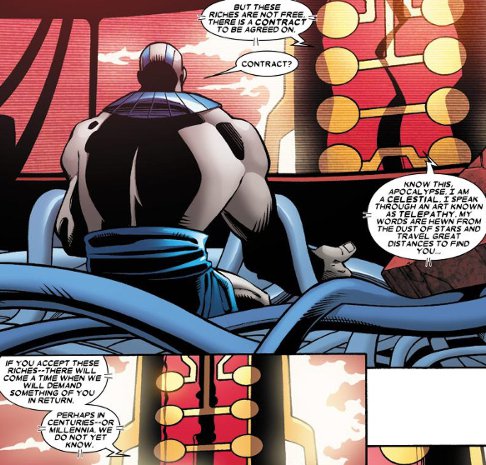
One day while hard at his labors, En Sabah Nur heard a voice calling him by the name of Apocalypse. Appearing on a large monitor, the face of a giant, armored being appeared. It explained to En Sabah Nur that it was a Celestial and it was speaking through an art known as telepathy. It further explained that Nur had inherited scientific riches, which would help him become a feared, powerful creature who might yet shape the world’s destiny, but that those riches were not free. Offering a “contract,” the Celestial explained that, if En Sabah Nur accepted the technology, then there would come a time when the Celestials would demand something in return, a payment which would cost him his life, or even more. [X-Men (2nd series) #186]
Considering that Celestials rarely made direct contact with other beings, their offer to En Sabah Nur must have been important to them. While the exact nature of their bargain is unknown, it is most likely related to the position or title that would later be referred as the “Celestial Gardener.” This officer of the Celestials, is seems, would be tasked with tending the “evolutionary garden” of the Earth. Since it seems that the Celestials never again contacted En Sabah Nur with further instructions or requests for status of his assigned task, it is unclear why the Celestials contacted En Sabah Nur at this time, or why at all. It could be possible that Celestials, being entities beyond the scope of mortals, might experience time differently than almost all others in the universe and could see the connection that they would one day share with the being that would become Apocalypse. Whatever their reasons, the Celestials’ deal was accepted and not a day passed thereafter that En Sabah Nur did not wonder if that was the day that the Celestials would come for him.
In the practice of natural selection, eliminating the weak is only part of the process, the other part being the passing on the genes of the strong to their progeny. So was it with Apocalypse. While seemingly never having again expressed sexual desire since his rejection by Nephri, Apocalypse nonetheless fathered children over the course of his life from women from around the world. Even though these progeny and their descendants were of diverse regional and ethnic origins, they all would feel a connection to each other greater than their respective heritages. The exact nature of Apocalypse’s relationship with his descendants is unknown, but they were utterly dedicated to his philosophy and acknowledged him as their living god. 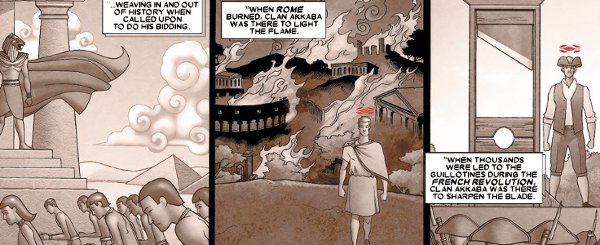 As his descendants, they likely considered themselves demi-gods, as demonstrated by their array of mutant abilities inherited from Apocalypse. If Hamilton Slade, the leader of this “Clan Akkaba” in the late 19th century is to be believed, their members weaved in and out of history at the bidding of their lord, sewing chaos and discord, such as the burning of Rome and the violence of the French Revolution. [Apocalypse vs. Dracula #1]
As his descendants, they likely considered themselves demi-gods, as demonstrated by their array of mutant abilities inherited from Apocalypse. If Hamilton Slade, the leader of this “Clan Akkaba” in the late 19th century is to be believed, their members weaved in and out of history at the bidding of their lord, sewing chaos and discord, such as the burning of Rome and the violence of the French Revolution. [Apocalypse vs. Dracula #1]
Although En Sabah Nur left Egypt to wander the world, he never forgot the land of his birth and took advantage of his immortal lifespan to set several schemes in motion that would play out over thousands of years. Among these were the Children of the Sun, a hereditary line of pharaoh worshippers founded to maintain a link to the pharaohs and their kingdom. Possibly through divinations of Ozymandias, En Sabah Nur learned the secrets of the fabled Twelve of Power, individuals who could provide him with the key to ultimate power, individuals which he would later deduce were mutants, once he learned that word. Over his long life, En Sabah Nur worked to manipulate the legend of the Twelve with obfuscation and false details so that their true use to him was kept a mystery. Apocalypse's plans required one of the Twelve to serve as a conduit for the energies of the others and he apparently knew this individual would one day rise from the blood of the pharaohs. He created the Children of the Sun to stand watch over Egypt in anticipation of the birth of this "Living Pharaoh," who would be a key player in the Gathering of the Twelve.

As the centuries and millennia passed, En Sabah Nur would grow in not only power, but in legend. Emerging from seclusion periodically, Nur would travel the world to determine if his time of testing had come. While he took many names along the way, En Sabah Nur would be known by most as simply Apocalypse, the end of all that is. In the late 20th century, the hero known as Cable would come across evidence of Apocalypse’s travels and influence while investigating his foe. [Cable: Blood & Metal #1]
In truth, these incidents were mere anecdotes to Apocalypse’s activities throughout the ages, with most instances having been lost of history. On such occurred in 2620 BC, a mere three hundred years after his birth and, by happenstance, in the land of his birth. One night, a mighty meteor landed just outside of the pharaoh’s palace in Egypt’s Giza plateau. When Pharaoh Khasekhemwy went to investigate, he was taken and transformed by the alien Brood, who had ridden the meteor from the stars to Earth’s surface. When the Brood began to multiply, ending the second great dynasty of Egypt in the process, Apocalypse was among many who were rallied by a mighty warrior named Imhotep, who intended to fight the end of mankind. The extent of En Sabah Nur’s involvement with and relationship to this mighty warrior is long forgotten. No doubt, En Sabah Nur intended to prove that humanity was strong. Little could he know was that this would begin a tradition of warriors acting as a shield, protecting humanity against the things that would stop them from becoming what they are supposed to be. [S.H.I.E.L.D. (1st series) #1]
As the centuries turned to millennia, En Sabah Nur created places of power, which in turn were visited by a few individuals brave enough to do so. Akhenaten, the Egyptian Pharaoh of Egypt in 1500 BC, visited En Sabah Nur’s lair in Akkaba, pleading for his favor and was rebuffed. In the 4th century BC, Alexander of Macedonia came defiantly informing the “god” that he was no longer needed by the world, only to be informed by En Sabah Nur that even after the world has fallen, he would still remain. [Incredible Hulk (2nd series) #457]

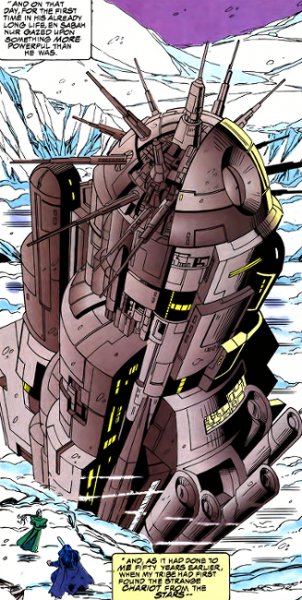
By the mid-12th century BC, En Sabah Nur had become a wandering warlord. In his journeys, he had heard whispers of an immortal magician and had made his way across the steppes of Mongolia to investigate. Though he would eventually take the name Saul, the Asian mage was currently called Garbha-Hsien. Although neither could explain it, both were men born differently from others. After having experiences with death, both Garbha-Hsien and En Sabah Nur had been resurrected with new and mighty powers. Eventually, as Saul, Garbha-Hsien would help form a group of similar beings who would call themselves Externals. Considering him a brother “forever walker,” Garbha-Hsien led En Sabah Nur to a gigantic craft of alien origin, which he called a “chariot from the stars” and which his own followers had discovered some decades before. Not wishing to share such a prize with anyone, Apocalypse dealt what he thought was a mortal blow to Garbha-Hsien and entered the craft. Hsien, still alive due to his immortal nature, watched En Sabah Nur enter the wondrous craft, whose secrets had been denied him for so long. [X-Force (1st series) #37]
Though he had gained entrance to the vessel, En Sabah Nur was no closer to discovering the secrets it contained. In a search for the metaphorical keys to this locked mystery, he continued his travels, testing the strong and winnowing the weak. Along the way, he acquired men of strength as followers, which he named his Dark Riders. During these expeditions, En Sabah Nur repeatedly came across an ever-present adversary known as the Traveler. En Sabah Nur could not know this, but the Traveler’s history was closely intertwined with his own. In truth, the Traveler was a time traveler, who had grown up in a dystopian future ruled by Apocalypse, the future identity of En Sabah Nur. Though he also would choose the name of Cable, at this time in his life the Traveler was jumping from one time period to another to learn all he could about his foe, to see how he could be stopped in the Traveler’s native time period. The two would fight numerous times, including in Dilmun and across the Phoenician sands.
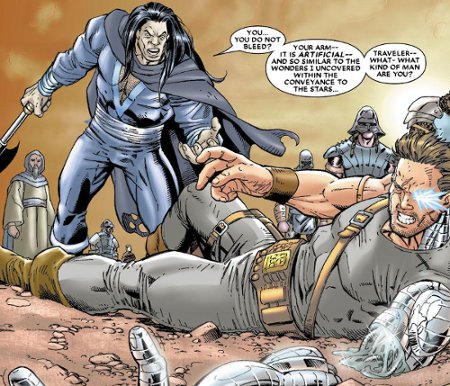 Having had enough, En Sabah Nur sought to end his foe once and for all and severed the Traveler’s left arm. To his shock, En Sabah Nur realized that the arm had not been encased in armor, but was artificial in nature and very similar to the wonders he had uncovered within the conveyance to the stars. In shock, En Sabah Nur demanded to know what kind of man his foe was, to which the Traveler replied that he was a man of the future. With that, he fired a handgun, shooting En Sabah Nur in the forehead and killing him instantly. Despite the Dark Riders declaring their allegiance to him, as they now deemed him the strongest, the Traveler departed, unaware that he had left behind something precious – a small pool of blood hemorrhaged from his techno-organic arm. [Cable & Deadpool #26]
Having had enough, En Sabah Nur sought to end his foe once and for all and severed the Traveler’s left arm. To his shock, En Sabah Nur realized that the arm had not been encased in armor, but was artificial in nature and very similar to the wonders he had uncovered within the conveyance to the stars. In shock, En Sabah Nur demanded to know what kind of man his foe was, to which the Traveler replied that he was a man of the future. With that, he fired a handgun, shooting En Sabah Nur in the forehead and killing him instantly. Despite the Dark Riders declaring their allegiance to him, as they now deemed him the strongest, the Traveler departed, unaware that he had left behind something precious – a small pool of blood hemorrhaged from his techno-organic arm. [Cable & Deadpool #26]
Still, death would not be the end of En Sabah Nur. Instead, Ozymandias took the corpse of his master back to the alien craft, hoping that the craft would revive him to his once and former greatness. Though imbued with visions of the future, Ozymandias remained primitive minded and what he found within the construct was nightmarish. Leaving En Sabah Nur within, Ozymandias left the craft, swearing that he would never again go back inside. Through a manner unclear, En Sabah Nur managed to incorporate the techno-organic properties of the Traveler’s blood into himself, the results of which finally allowed him to communicate with craft’s artificial intelligence.
For years, En Sabah Nur bonded both physically and mentally with the vessel, regenerating slowly from death to his former strength and learning the craft’s secrets as he did so. It was in this state that he once again encountered the Traveler. Having come across Ozymandias again and seeing him trading advanced technology, the Traveler learned the truth of En Sabah Nur’s resurrection and forced the servant to bring him to his master. 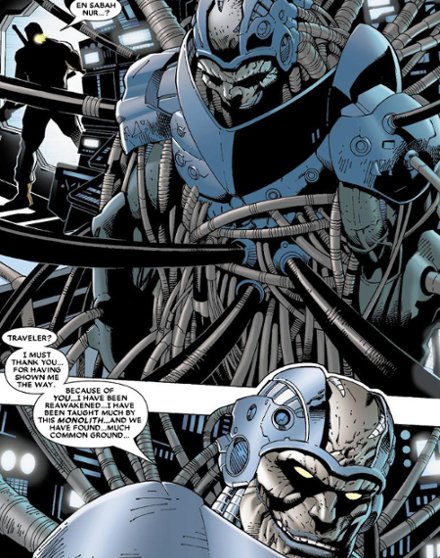 Immediately, the Traveler recognized the craft as being Celestial in origin and entered, where he found En Sabah Nur literally plugged into the Celestial vessel. En Sabah Nur gloated that his old foe’s blood had given him a new chance at life and the means by which to communicate with the alien ship. The Traveler, however, had the last laugh. Since his own techno-organics spoke the same machine language as the ship, the Traveler programmed the vessel to launch into deep space, taking En Sabah Nur with it. However, the Traveler nonetheless knew that it was a hollow victory, as En Sabah Nur would eventually return… as Apocalypse. [Cable & Deadpool #27]
Immediately, the Traveler recognized the craft as being Celestial in origin and entered, where he found En Sabah Nur literally plugged into the Celestial vessel. En Sabah Nur gloated that his old foe’s blood had given him a new chance at life and the means by which to communicate with the alien ship. The Traveler, however, had the last laugh. Since his own techno-organics spoke the same machine language as the ship, the Traveler programmed the vessel to launch into deep space, taking En Sabah Nur with it. However, the Traveler nonetheless knew that it was a hollow victory, as En Sabah Nur would eventually return… as Apocalypse. [Cable & Deadpool #27]
[Note: The story of En Sabah Nur discovering the Celestial ship was told by Garbha-Hsien (aka Saul) in X-Force (1st series) #37. In his story, he off-handedly states that it was the 12th century, but did not specify AD or BC. While one might automatically think he meant AD, the story depicted in Cable & Deadpool #26-27, which undeniably take place after the X-Force story, is noted by captions to have occurred “thousands” of years ago and not “hundreds.” Additionally, En Sabah Nur’s references to “Dilmun” and the “Phoenician sands” refers to civilizations that fell in the 1st millennium BC. It would make more sense if they were contemporary, still living civilizations in the 12th century BC, rather than ones that fell two thousand years before from the point of view of someone in the 12th century AD. Finally, in other stories, En Sabah Nur was shown to have fully become the Celestial armor-wearing Apocalypse at least by the 11th century AD, which could not be the case if he was only exposed to Celestial technology in the 12th century AD.]
It’s unknown how long En Sabah Nur traveled as an unwilling prisoner of the Celestial ship but it is unlikely to have lasted for more than a century. At some point in the mid-11th century BC, En Sabah Nur, now Apocalypse, came into conflict with the Eternals. If he had truly mastered the alien vessel, Apocalypse would have learned more of its creators, the genetic altering Celestials, with whom En Sabah Nur had made a bargain a thousand years before. He would have learned of their first visit to Earth one million years previously, when they had tinkered with early human DNA, providing the seed by which mutants would eventually emerge. The Celestials had returned in 23,000 BC and it was probably during this visitation that they had left the craft which Apocalypse now controlled. If he had learned all of this, Apocalypse would also have learned of the two offshoots of humanity created by the Celestials, the beautiful Eternals and the hideous Deviants. When they came to blows against him over the skies of Egypt, the Eternals noted that Apocalypse wore armor made of impenetrable Deviant alloy. Most likely, Apocalypse had wasted no time after his return to Earth in investigating the Celestials’ handiwork, first coming into contact with the Deviants, which in turn brought him to the attention of the Eternals. Whatever happened between Apocalypse and these two separate forces is unknown, but to the mortal humans below it must have seemed a battle between the gods. [Eternals (4th series) #4]
When they came to blows against him over the skies of Egypt, the Eternals noted that Apocalypse wore armor made of impenetrable Deviant alloy. Most likely, Apocalypse had wasted no time after his return to Earth in investigating the Celestials’ handiwork, first coming into contact with the Deviants, which in turn brought him to the attention of the Eternals. Whatever happened between Apocalypse and these two separate forces is unknown, but to the mortal humans below it must have seemed a battle between the gods. [Eternals (4th series) #4]
Already having obtained some technology from Rama-Tut’s ship, Apocalypse no doubt added whatever technology he acquired from his Celestial craft to that acquired from both the Deviants and Eternals, employing them all over the thousands of years that followed. Some of this technology he would use to transform followers into his “Horsemen,” usually augmenting their natural powers into something greater. [Uncanny X-Force (1st series) #3, Apocalypse vs. Dracula #1, Uncanny Avengers (1st series) #6] With other technology, he would create bases of operations in remote locations, such as the Moon and the Savage Land. [X-Factor (1st series) #65-68, Wolverine: The Jungle Adventure]
Additionally, over the course of his history using Celestial technology, Apocalypse employed more than one Celestial vessel. Shortly after his modern debut just a few years ago, Apocalypse possessed a massive vessel with artificial intelligence that was later acquired and used by the original X-Factor. Originally simply called “Ship,” this vessel’s artificial intelligence eventually evolved into an entity calling itself Prosh. At first, Ship/Prosh believed itself to have been created by Apocalypse, but later learned of its connection to the Celestials. It’s unclear as to whether this vessel was the same that En Sabah Nur had stolen from Garbha-Hsien or if it was another. Anecdotal evidence suggests that Ship/Prosh had been either acquired some seven centuries before (circa the 13th century AD) or simply that Apocalypse had gained “mastery” over the vessel around this time. [Tales from the Age of Apocalypse - By the Light] Given Ship/Prosh’s misunderstanding of the nature of its creation, it could be that Apocalypse had finally gained ultimate control at this time and erased its memory. Or, it could have been a completely different vessel. It is known that Apocalypse had access to another ship of this design, albeit much smaller, which had been employed by his Clan Akkaba followers, to be used in the event of his ultimate destruction to resurrect him. [Uncanny X-Force (1st series) #1-4]
At some point during the centuries following his return to Earth, Apocalypse came back into contact with Rama-Tut, or at least a future version of him. Already being a time traveler himself, Rama-Tut had lived for more centuries and eventually assumed the identity of Kang the Conqueror. Now needing assistance in the past to help enact a 21st century plan, Kang reassumed the identity of the usurped pharaoh, knowing it would be more familiar to the still primitive-minded Apocalypse. By the early 11th century, the two had entered a treaty of some sort, with “Rama-Tut” directing Apocalypse’s attention to individuals whom Rama-Tut claimed would “muddle” Apocalypse’s plans in the future. In truth, these were future foes of Rama-Tut and not Apocalypse, but Rama-Tut gave no hint to this fact.
It’s unclear what Rama-Tut offered Apocalypse in the bargain, but it could have been access to time travel technology, as an Apocalypse looking the very same between each instance would select four individuals from eras ranging from the 3rd century to the 19th century to become his Final Horsemen. [Uncanny X-Force (1st series) #3] Whatever incentive was part of their bargain, Apocalypse was directed by Rama-Tut at Thor, the Norse god of thunder. Coming upon him in a tavern in Scandinavia in the year 1013, Apocalypse fought and bested the godling, who ultimately fled back to Asgard to gather a weapon that could break Apocalypse’s seemingly indestructible armor. With his first foe fled, Apocalypse moved on to his second target, the ancestor of a man who would purportedly undo his future.
 Unable to know that his descendant would be the X-Men known as Wolverine, Folkbern Logan was a simple English night watchman stationed on London Bridge. Folkbern was manning his post when he was suddenly attacked by the Horsemen of Apocalypse. A mere human with nothing but a spear, Folkbern would surely have died if not for the timely arrival of Thor. During his return to Asgard, Thor had used one of Odin’s spells to augment his ax, Jarnbjorn, against Celestial-armor, which Apocalypse now wore. With Jarnbjorn, Thor easily killed the four Horsemen of Apocalypse and then set his sights on Apocalypse’s pyramid craft and Apocalypse himself within. To his surprise, Apocalypse too found himself vulnerable to Thor’s ax and decided that it was best to depart. However, he intended for the craft to become Thor’s tomb and activated the techno-pyramid’s self-destruct. Luckily for him, Thor managed to escape, partially due to the swiftness of his flying chariot, drawn by the magical goats, Toothgnasher and Toothgrinder. [Uncanny Avengers (1st series) #6]
Unable to know that his descendant would be the X-Men known as Wolverine, Folkbern Logan was a simple English night watchman stationed on London Bridge. Folkbern was manning his post when he was suddenly attacked by the Horsemen of Apocalypse. A mere human with nothing but a spear, Folkbern would surely have died if not for the timely arrival of Thor. During his return to Asgard, Thor had used one of Odin’s spells to augment his ax, Jarnbjorn, against Celestial-armor, which Apocalypse now wore. With Jarnbjorn, Thor easily killed the four Horsemen of Apocalypse and then set his sights on Apocalypse’s pyramid craft and Apocalypse himself within. To his surprise, Apocalypse too found himself vulnerable to Thor’s ax and decided that it was best to depart. However, he intended for the craft to become Thor’s tomb and activated the techno-pyramid’s self-destruct. Luckily for him, Thor managed to escape, partially due to the swiftness of his flying chariot, drawn by the magical goats, Toothgnasher and Toothgrinder. [Uncanny Avengers (1st series) #6]
Though he continued to travel the world, Apocalypse maintained a presence at the place of his birth, Akkaba. Though this location remained a place of solitude, as in the past some would seek him out. In the 12th century, during the conflict known as the Crusades, French knight Bennet du Paris had come into possession of an ancient map. Discovered in the aftermath of the conquest of Jerusalem, the map showed the location of the ancient city of Akkaba in the area known as Palestine. Seeking out the reported ancient Tower of Power, Paris was greeted by the disembodied voice of Apocalypse. Striking a deal, Apocalypse unleashed the latent mutant powers of Paris, transforming him into something more. Exodus, drunk with his new power, quickly turned on his new master. In turn, Apocalypse stripped Exodus of much of the power he had just given him and left Paris in a coma-like state, in which he would remain for over eight hundred years. [Black Knight: Exodus]
To Apocalypse, the wars of the world served the purpose of weeding out the weak, so that the strong could thrive. However, it seems like these conflicts also served an opportunity for Apocalypse to test the victors, for in his opinion even the strong should be tested. When Pope Pius II called in 1459 for a new Crusade against the Ottoman Empire, which had been encroaching upon the Balkans, the Romanian prince Vlad Tepes answered the call. Though he and his forces succeeded in their battle against the Turkish army, Vlad and his men imediately thereafter found a new enemy in the Riders of the Dark and the Horsemen of Apocalypse. As his men fell to the Dark Riders, Vlad himself fell in single combat against the Horseman called War. Apocalypse had apparently not deemed Prince Vlad worthy for death at his own hand. [Apocalypse vs. Dracula #1]
Though felled, Vlad was not yet dead and was brought to a gypsy healer named Lianda. However, in truth Lianda was a vampire and she turned Vlad into one of her kind in revenge for his persecution of gypsies in the past. In time, the reborn Vlad would become known as vampire named Dracula, greatest of his kind, and he would spend in the next four centuries plotting his revenge against Apocalypse. [Dracula Lives (1st series) #1, Apocalypse vs. Dracula #4]
Sometime in the early to mid-19th century, a young girl named Margaret Slade, one of the latest generation of Clan Akkaba and the eventual mother of Hamilton Slade, witnessed Apocalypse single-handedly cut a whole tribe of N’Gari demons to pieces. The details of this attempted extra-dimensional invasion or the involvement of either Apocalypse or Clan Akkaba has been lost to time. [Apocalypse vs. Dracula #4]
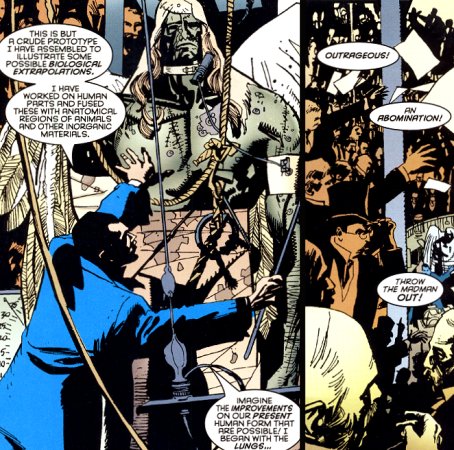
It’s possible Clan Akkaba played some part in guarding Apocalypse as he slumbered through his periodic hibernations, though they were definitely not always present when he did so. The next known emergence of Apocalypse was in the mid-19th century. In the year 1859, a brilliant British scientist named Nathaniel Essex had become obsessed with the theories of natural selection as proposed by Charles Darwin. Believing that Darwin was too conservative in his theories, Essex was ousted by the London Royal Society when he addressed them with his own theories, complete with examples made up of parts spliced from cadavers of both human and animal.
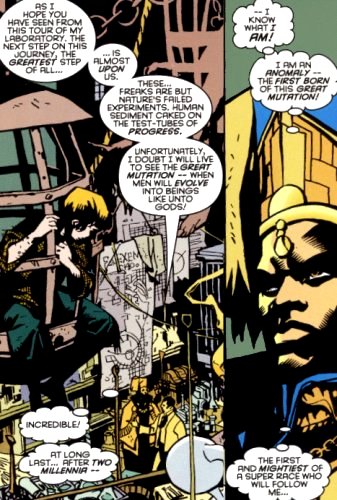 Undeterred, Essex continued his work by experimenting on the homeless and indigent, all brought to him by a group of thugs in his employ, called the Marauders. In search of more subjects, the Marauders came upon the ancient Apocalypse, newly awakened from hibernation. Ironically, Apocalypse admired the Marauders’ tactics of preying on the weak. Hearing of their employer, Essex, and his experiments, Apocalypse bid them to take him to this man. Once introduced, Essex showed Apocalypse his laboratory and shared with him his theories. Finally, Apocalypse learned the scientific term for beings like himself – mutants.
Undeterred, Essex continued his work by experimenting on the homeless and indigent, all brought to him by a group of thugs in his employ, called the Marauders. In search of more subjects, the Marauders came upon the ancient Apocalypse, newly awakened from hibernation. Ironically, Apocalypse admired the Marauders’ tactics of preying on the weak. Hearing of their employer, Essex, and his experiments, Apocalypse bid them to take him to this man. Once introduced, Essex showed Apocalypse his laboratory and shared with him his theories. Finally, Apocalypse learned the scientific term for beings like himself – mutants.
Together, Apocalypse and Essex, along with the enigmatic Hellfire Club, a secret society of Britons seeking power, plotted their strategy of global upheaval. As in the past, Apocalypse’s life intersected with the arrival of time travelers from the future.  Apocalypse and Essex were unable to know the true identity of these two mutants as Cyclops and Phoenix, members of the future hero team known as the X-Men. Sent back in time to prevent the ascendancy of Apocalypse, the two were nevertheless quickly captured. Bound and unable to use his mutant power, Cyclops plead with Essex not to accept his unholy pact with Apocalypse. However, after being rejected by his contemporaries and his own wife, Essex had nothing left to live for… except science.
Apocalypse and Essex were unable to know the true identity of these two mutants as Cyclops and Phoenix, members of the future hero team known as the X-Men. Sent back in time to prevent the ascendancy of Apocalypse, the two were nevertheless quickly captured. Bound and unable to use his mutant power, Cyclops plead with Essex not to accept his unholy pact with Apocalypse. However, after being rejected by his contemporaries and his own wife, Essex had nothing left to live for… except science.
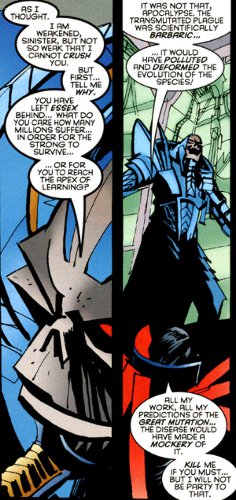 Transformed by the machinery of Apocalypse, Essex, now renamed Mister Sinister, had clarity of purpose and immediately realized that this purpose was in direct opposition to Apocalypse's. He saw that Apocalypse's first command, that of the creation of a plague to ravage the population of the world, was madness... and poor science. While ice water now flowed through his veins, cruelty for its own purpose was ignorance. And ignorance, Sinister stated, is the greatest enemy of science. Quickly, Sinister decided to betray his new master. Instead of creating a plague to ravage and transmutate the world's population, he created a plague to attack only Apocalypse. Weakened by this attack, Apocalypse returned to his hibernation sanctuary and entered his regeneration chamber, which teleported away to safety. Before departing, Apocalypse had forgiven Sinister for his treachery, with the understanding that it would not be tolerated again. After his master’s departure, Sinister came to a decision. As it was only a matter of time before Apocalypse returned, Sinister must use that time to devise a way to destroy him. [Further Adventures of Cyclops & Phoenix #1-4]
Transformed by the machinery of Apocalypse, Essex, now renamed Mister Sinister, had clarity of purpose and immediately realized that this purpose was in direct opposition to Apocalypse's. He saw that Apocalypse's first command, that of the creation of a plague to ravage the population of the world, was madness... and poor science. While ice water now flowed through his veins, cruelty for its own purpose was ignorance. And ignorance, Sinister stated, is the greatest enemy of science. Quickly, Sinister decided to betray his new master. Instead of creating a plague to ravage and transmutate the world's population, he created a plague to attack only Apocalypse. Weakened by this attack, Apocalypse returned to his hibernation sanctuary and entered his regeneration chamber, which teleported away to safety. Before departing, Apocalypse had forgiven Sinister for his treachery, with the understanding that it would not be tolerated again. After his master’s departure, Sinister came to a decision. As it was only a matter of time before Apocalypse returned, Sinister must use that time to devise a way to destroy him. [Further Adventures of Cyclops & Phoenix #1-4]
Apocalypse did not hibernate long in this regeneration cycle, as he was awakened a mere two years later by Clan Akkaba, who required his help. Viewing a request for aid as weakness, Apocalypse had developed a tradition over the ages that one of the group requesting aid would be killed by him as punishment for their lack of strength. The details of this request from Clan Akkaba is again lost to history, but would be the last time they would entreat their lord and master for 36 years. [Apocalypse vs. Dracula #2]
Around this time, or a few years after, Apocalypse encountered a young Professor Abraham van Helsing, who was just beginning his long career as a vampire hunter. At first, the young van Helsing thought Apocalypse might be a member of the undead but was somehow convinced otherwise during the course of their encounter. [Apocalypse vs. Dracula #2]
By the end of the 19th century, the number of members of Clan Akkaba had dwindled to a little over a dozen, all of whom had congregated in London, the capital of the then most powerful nation on the planet. Though the general populace of the city knew nothing of Apocalypse or Clan Akkaba, they knew of the power of the family that controlled Alexandria House, where the clan held their meetings.
In 1897, when lesser members of their family were being systematically killed, the clan’s leader, Hamilton Slade, went looking for answers, only to disappear himself. Realizing they needed help, the clan beseeched Ozymandias to awaken Apocalypse. During the meeting, it was Jack Starsmore, a lesser member of the clan, who provided the insight into their foe by introducing an outsider of whom Apocalypse had already been acquainted, Professor Abraham van Helsing. Despite the rest of the clan’s disbelief, van Helsing convinced Apocalypse that their true foe was Dracula, the king of vampires who had once been defeated by Apocalypse over four centuries before. [Apocalypse vs. Dracula #1-2]
Though Apocalypse had given no further thought to the Romanian prince from so long ago, Dracula had spent the centuries plotting revenge, learning all that he could about his old foe. By draining the blood of Apocalypse’s descendants, Dracula was absorbing the power that blood contained. Additionally, once the murders drew him out of his hibernation, Dracula destroyed Apocalypse’s regeneration sarcophagus. Finally, turning the “fittest” of Clan Akkaba, Hamilton Slade, into a vampire, the forces of Dracula ambushed the remaining members of Clan Akkaba at Alexandria House, either killing them or turning them into vampires. By the time they realized what was happening, Apocalypse’s only remaining allies were Ozymandias, van Helsing, Jack Starsmore and the crippled clan member Frederick Slade. Nevertheless, the group fought off an attack by Dracula’s forces, but not before one of their vampires had bitten Apocalypse. With the protection of the new day’s sunlight, the group finished off the remaining vampires of Clan Akkaba and burned down Alexandria House. By Apocalypse’s decree, Clan Akkaba would be no more.
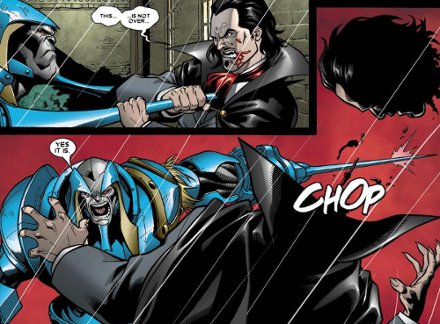 Because of having been bitten, Apocalypse sensed Dracula’s location in his home in Transylvania and so the group quickly traveled their via Frederick’s power of teleportation. This too was a trap, though, as Dracula had assembled his own army of the undead, which awaited their master’s old foe. However, Apocalypse was not without his own surprises and had summoned this Riders of the Dark, the first assemblage of the warriors in centuries. Still, victory seemed in Dracula’s grasp, as the bite Apocalypse had incurred had not only diminished his strength but also forced him to obey the king of vampires. It was only the timely intervention of van Helsing that provided Apocalypse the opportunity to strike back and decapitate Dracula. His foe vanquished and his clan all but extinct, Apocalypse departed, presumably headed toward another hibernation sarcophagus hidden in another place of seclusion. Little did Apocalypse know that Ozymandias, for reasons of his own, took steps to make sure that Clan Akkaba continued through the progeny of Jack Starsmore and Frederick Slade. [Apocalypse vs. Dracula #3-4]
Because of having been bitten, Apocalypse sensed Dracula’s location in his home in Transylvania and so the group quickly traveled their via Frederick’s power of teleportation. This too was a trap, though, as Dracula had assembled his own army of the undead, which awaited their master’s old foe. However, Apocalypse was not without his own surprises and had summoned this Riders of the Dark, the first assemblage of the warriors in centuries. Still, victory seemed in Dracula’s grasp, as the bite Apocalypse had incurred had not only diminished his strength but also forced him to obey the king of vampires. It was only the timely intervention of van Helsing that provided Apocalypse the opportunity to strike back and decapitate Dracula. His foe vanquished and his clan all but extinct, Apocalypse departed, presumably headed toward another hibernation sarcophagus hidden in another place of seclusion. Little did Apocalypse know that Ozymandias, for reasons of his own, took steps to make sure that Clan Akkaba continued through the progeny of Jack Starsmore and Frederick Slade. [Apocalypse vs. Dracula #3-4]

